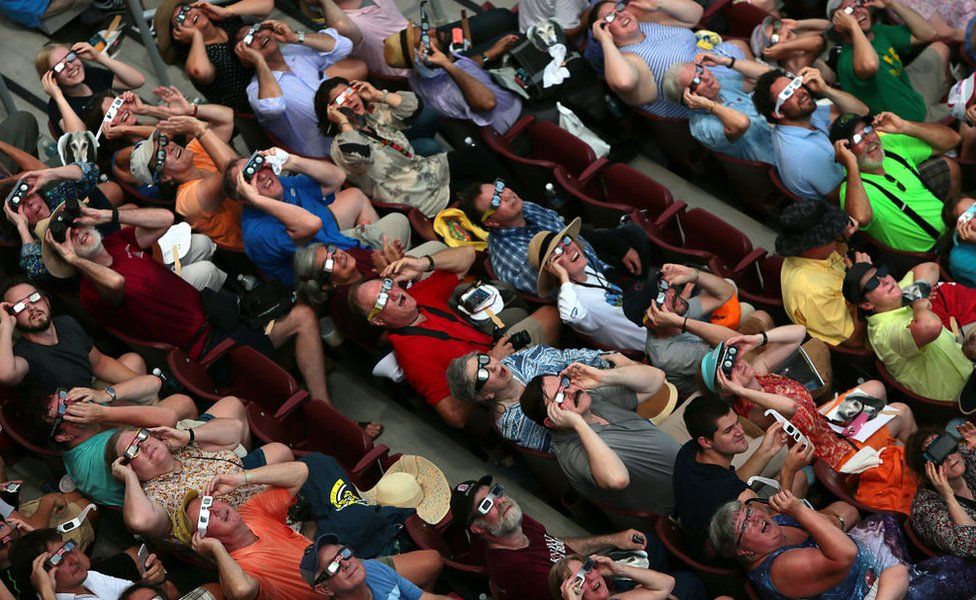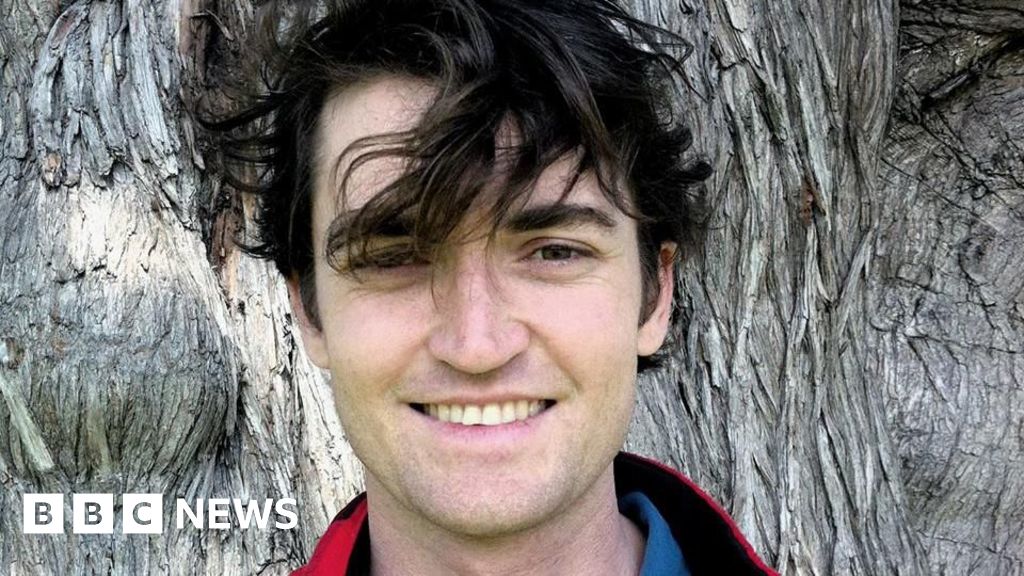ARTICLE AD BOX
 Image source, Getty Images/St Louis Post-Dispatch
Image source, Getty Images/St Louis Post-Dispatch
The good people of Carbondale get to do it all over again, and for longer
How lucky can the residents of Carbondale, Illinois, be?
Celestial mechanics says any one spot on the Earth's surface should experience a total solar eclipse only once every 375 years, on average.
The 30,000 residents of the Midwestern city will probably chuckle at that statistic because they are about to witness the Moon block out the Sun's disc for the second time in just seven years.
And what's more, the upcoming 8 April eclipse will be even better than the one they got to see in 2017. The sky will go pitch black for 4 minutes and 9 seconds, nearly double what happened last time.
Image source, Getty Images
As many as 200,000 people are expected to flood prime viewing locations in southern Illinois for The Great American Eclipse, Part II. But this will be true, also, all along the eclipse path, from Mexico's Pacific coast to Canada's Atlantic seaboard. The upcoming event is set to be a blockbuster.
In 2017, the path of deepest shadow - "totality" - ran from Oregon in the US north-west to South Carolina in the south-east. That actually covered some sparsely populated regions, including many national parks.
The 2024 event, in contrast, will cover some major US urban areas, such Dallas, Indianapolis, Cleveland, and Buffalo.
"This is going to be the most populated eclipse in the US, with 31.5 million people able to just walk outside of their homes to experience it," Dr Kelly Korreck, the US space agency's eclipse programme manager, told BBC News.
Image source, SWRI/NASA
Image caption,Artwork: Jets equipped with Nasa instruments will chase the shadow
As you'd expect, Nasa will be doing understated experiments on the day, such as launching rockets into the shadow cast by the Moon to see how it affects the top of the Earth's atmosphere, or its ionosphere. Instrumented jet planes will also chase the shadow.
"The reason that we're flying aeroplanes, besides the fact that it's really cool, is because getting up high into the atmosphere means you can actually access wavelengths of light you can't do from the ground," said Dr Amir Caspi from the Southwest Research Institute.
The 2024 total solar eclipse will begin way out in the Pacific Ocean, with the inhabitants of Penrhyn Atoll, part of the Cook Islands, greeted by a darkened Sun at dawn, at 06:40 CKT (16:40 GMT).
The Moon's shadow, or umbra, will then race across the Earth's surface at more than 2,500km/h (1,500mph), crossing the Mexican coast at 11:07 MST (18:07 GMT) and the Rio Grande border between Mexico and the US at 13:27 CDT (18:27 GMT).
Image source, Getty Images
The journey continues up through 13 US states, before sweeping into the Canadian provinces of New Brunswick (16:32 ADT; 19:32 GMT) and Newfoundland (16:39 ADT; 19:39 GMT).
The Moon's shadow will lift off the Earth's surface in the Atlantic Ocean at 21:55 CEST (19:55 GMT), about 1,120km (700 miles) west of Normandy, France.
Sorry, Europe; maybe next time.
A special day: A promotional poster from the astronomer and artist Tyler Nordgren (Credit: tylernordgren.com)
Keen sky-watchers largely have their plans already in place.
They'll have studied transport and accommodation options and paid close attention to historic weather patterns.
The chances of avoiding confounding clouds are best in Mexico and Texas. But in truth, on any one day, in any one place, the weather could be your friend or a killjoy - and that applies to Carbondale, too.
Image source, S R Habbal and M Druckmüller
Image caption,A total solar eclipse affords a rare opportunity to study the Sun's corona
You might think that with all the space telescopes trained on the Sun these days that there's very little an eclipse can add to the sum of solar knowledge.
But total eclipses are special because they afford favourable conditions to study the tenuous outer atmosphere of the Sun - its corona.
It is in this magnetised, superheated "gas" of charged particles that the solar wind originates, and from which billions of tonnes of matter can occasionally burst towards the Earth to disrupt satellites, communications and even electricity grids.
The corona is outshone by the Sun's surface, its photosphere. Satellites will block out the glare using devices called coronagraphs, but those are usually so wide that they also obstruct the view of light immediately above the edge of the star. It's in this zone where the corona's key processes are occurring.
Only during an eclipse, when the Moon's disc just matches that of the Sun, do all aspects of the corona become accessible.
Image source, Aberystwyth University
Image caption,UK and US scientists have been working on eclipse observations
British scientists have teamed up with Nasa to deploy instruments in Dallas. They'll have a polarimeter to examine the directional quality of the corona's light and a spectrometer to look for the behaviour of excited iron atoms.
"During an eclipse, nature gives us a unique opportunity to measure this region with relative ease, and to see the connections between the Sun and solar wind," explained Dr Huw Morgan from Aberystwyth University.
Image source, AFP
Image caption,However you watch the eclipse, doing it safely is paramount.
But you don't need to be a professional scientist to participate in eclipse science. There are numerous citizen research projects. For example:
- The Sunsketcher initiative needs help measuring the precise shape of the Sun. Yes, it's round, but ever so slightly squished at the poles.
- Eclipse Soundscapes will record how the natural world, particularly animals, react when plunged into darkness. Bees quit flying, apparently.
- The Globe Observer project needs help recording temperature changes and the behaviour of clouds.
- And Eclipse Megamovie will once again employ an army of DSLR cameras to capture an extended view of the event.
"Having people all along the path is going to be a force multiplier for these observations and enable us to take longer observations and more correlate what's happening and changing," said Nasa's Dr Liz MacDonald, who's been coordinating a lot of citizen science activity.
Get out there and enjoy it, but do it safely. Don't look at the exposed Sun with the naked eye.
Montana and North Dakota will see the tail end of a total solar eclipse in 2044, but the next such event to cross a broad swathe of the US won't occur until the following year.
"It's special," said Dr Korreck, "that's why you should try to experience it".

 10 months ago
70
10 months ago
70








 English (US) ·
English (US) ·